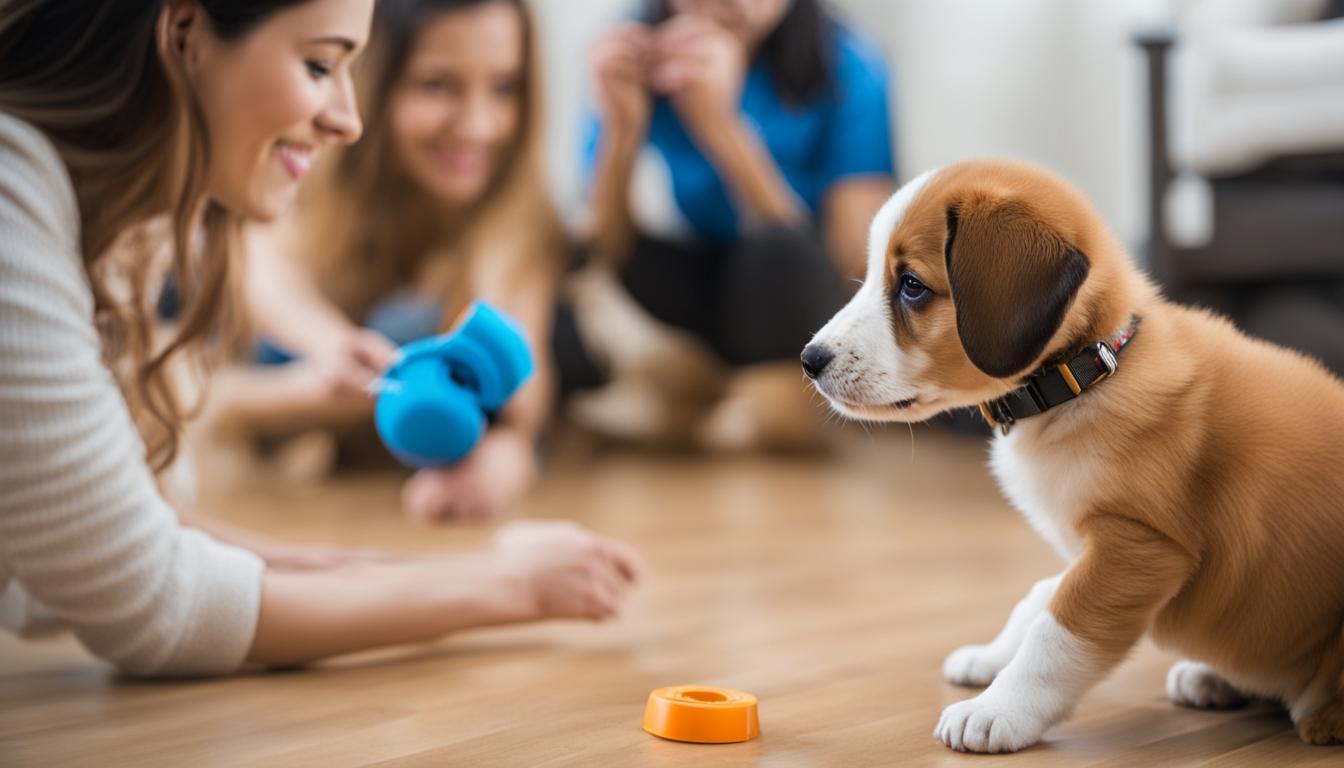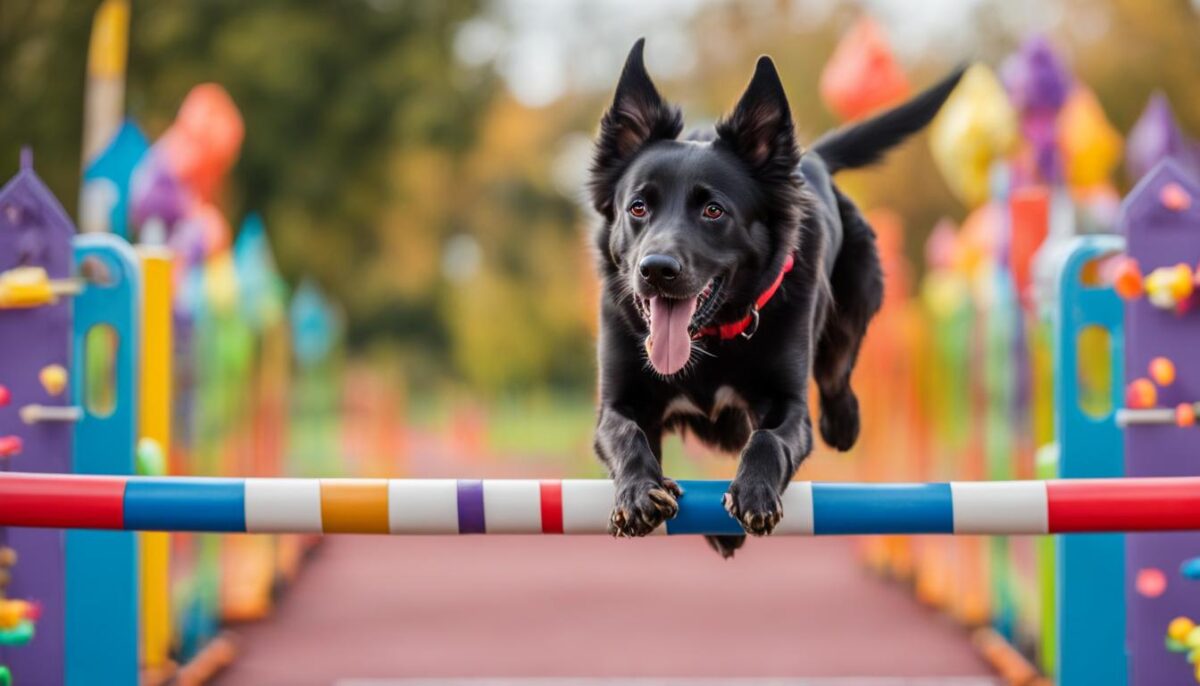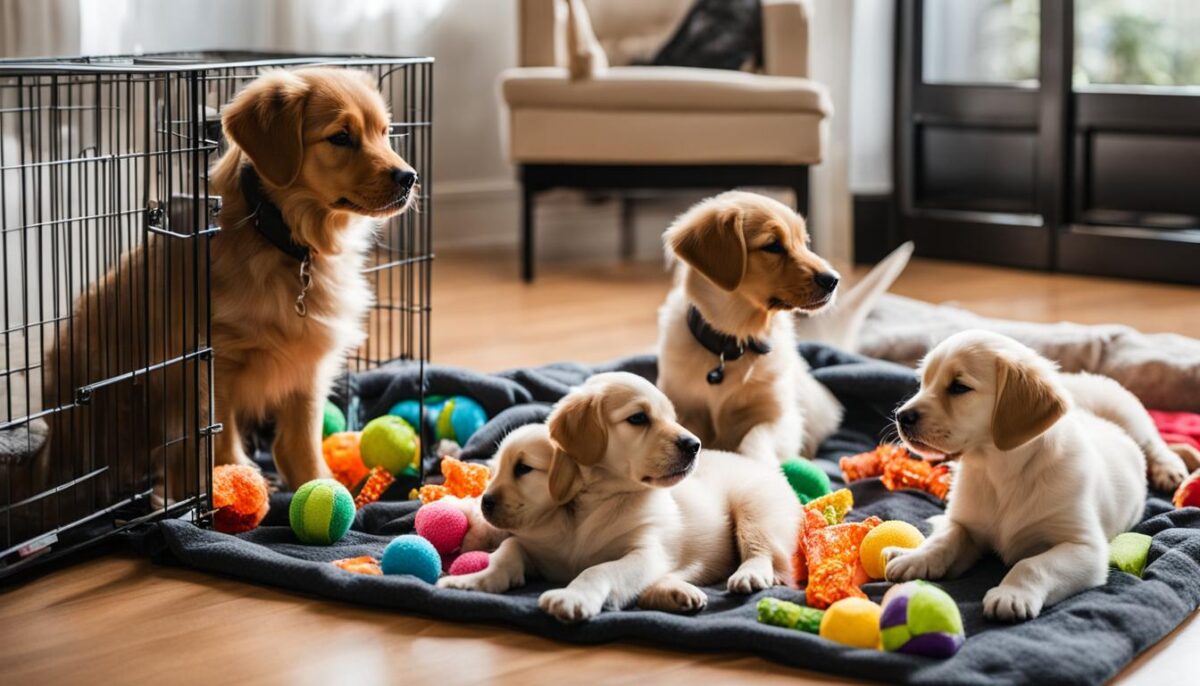Hi there! You want to train your dog right at home, right? That’s a big, fun step for both you and your furry friend. It’s okay if you’re just starting; beginner dog training is all about those first simple steps. You can teach your dog cool things like how to sit and stay. You can also help your dog learn to come when you call. These are some of the puppy training basics.
Another big part of learning together is about making friends and seeing new places. We call this dog socialization. It’s when your dog gets used to meeting different people and exploring new spots. This helps your dog to not be scared or shy and be a very good boy or girl.
And guess what? All this dog training at home isn’t just about rules and lessons; it’s also about playtime and fun. It makes you and your dog best buddies. If this sounds like something you want to do, you’re in the right spot! Let’s start a happy and safe journey with your doggo!
Key Takeaways
- Start with basic commands like sit, stay, and come.
- Use fun and treats to make training a great time.
- Help your dog make new friends with dog socialization.
- Keep lessons simple and happy to bond with your dog.
- Teach your dog step by step and be patient.
Preparing for Home Dog Training
Before you start training your furry friend at home, it’s smart to know what they need and how to set everything up for success. Training your dog is important, just like giving them food or love. Let’s make sure you’re ready to teach your dog in the best way!
Understanding Your Dog’s Training Needs
Dogs need training to live happily with us. Training helps them understand what you want, like sitting instead of jumping on people. Starting with easy things like ‘sit’ and ‘stay’ can make a big difference. These lessons are part of your dog’s basic needs and help them know how to act nicely.
Establishing a Training Foundation
Training protocols are like rules for teaching. They make sure your dog learns at their own pace. Positive reinforcement is a kind way to make sure they know they’re doing a good thing. When they do something right, a treat or a happy “Good dog!” can make them want to do it again.
Essential Training Supplies and Environment
For dog training essentials, you’ll want some treats, a leash, and maybe some toys. These tools help you teach and make learning fun. Pick a quiet place so your dog won’t be distracted, and you can both focus on the training.
Remember, patience is key! Every dog learns at their own speed, and it’s okay if it takes a little while. You’re both learning together. Now go ahead and start this adventure with your pup!
Positive Reinforcement Techniques
Training your beloved pup can be as simple as playing a game. How? By using what we call positive reinforcement training. It’s about giving your dog something they love to make them repeat the good stuff. Let’s say your furry friend does something great, like sitting when asked. You can give them treats for training or a big hug, letting them know they’ve done a good job.
Now, there’s this neat trick with doggy doorbells. Hang them by the door and teach your four-legged buddy to ring them when it’s potty time. With a little practice, your dog will be jingling those bells instead of waiting for you to guess what they need. And yes, once they ring the bell, and go outside to do their business, it’s reward time!
- Rewarding good behavior – Catch your dog being good and give them some love or a tasty treat.
- Ignoring not-so-good behavior – If your dog does something naughty, don’t give it much fuss. They’ll learn it’s not the way to earn treats or cuddles.
- Practice makes perfect – The more you repeat these steps, the better your dog will get at understanding the rules.
Remember, your dog wants to make you happy, so show them how with lots of positivity and encouragement.
How to Train a Dog at Home
Hey there! Are you ready to teach your furry friend some new tricks? Dog obedience training can be super fun and doesn’t have to take all day. Let’s break it down into easy steps with basic dog commands, playtime, and knowing how long to train.
Step-by-Step Training for Basic Commands
First things first, let’s talk about teaching your dog the basics. Commands like “sit”, “stay”, “come”, and “down” are a great start. Remember, keep it simple and be patient. If you repeat the steps and give your pup lots of love, they’ll get it!
Incorporating Play and Rewards in Training
Training is way more fun when it feels like a game! Use toys and treats to make it exciting. When your dog does something right, celebrate with them! A little playtime can turn into a learning moment.
Training Sessions: Duration and Frequency
Short training periods work best—about 5 to 10 minutes long. Try to do a few fun training sessions each day. Too much at once can be tiring for both you and your doggo, so keep it brief and upbeat!
- Start with one command at a time
- Use rewards like treats and toys
- Practice every day, but keep sessions short
Sounds pretty doable, right? With love, patience, and these handy tips, you’ll have a well-trained pup in no time. Happy training!
Housebreaking and Crate Training
Welcome to the part of your journey where you teach your furry friend where it’s okay to go potty. A little patience and these tips can make all the difference in housebreaking your dog and crate training puppies. Doing this the right way helps your puppy understand they have a special spot to relax and helps you avoid cleaning up little messes at home. Let’s dig into making potty time hassle-free!
The Basics of Crate Training
Starting with crate training can seem tough, but think of it as giving your pup a cozy bedroom. First, choose a crate that’s the right size for your dog – big enough to stand, turn around, and lie down. Begin by putting their favorite blanket or toy inside to make it feel like home. Remember, the crate is their safe place, not a punishment. Keep the door open at first and let your puppy explore. Soon, they will start going into their crate on their own!
Methods for Effective House Training
Now that your puppy is getting used to the crate, it’s time for some potty training rules. Take your pup to the same spot outside every time they need to go. Dogs love routine, so try to go out at the same times each day, like right after meals and naps. And when they do their business in the right spot, give them lots of praise – a happy dance, a treat, or a gentle pat will do!
Managing Submissive and Excitement Urination
Young puppies can get super excited or a little scared sometimes, and whoops – a little accident happens. This is called excitement urination. It’s normal and they usually grow out of it. To help, keep greetings low-key to avoid getting them too worked up. If they tinkle when scared or being submissive, avoid punishment since it can actually make things worse. Clean up quietly and give them time to mature.
Keep at it, and with consistency and love, your dog will be a potty-pro in no time!
Leash Training and Socialization Essentials
Taking your furry friend for a walk is not just an exercise; it’s an important part of learning good manners. Leash training is something every dog needs to master. Starting with a comfy leash and a little patience, you can teach your dog to follow your lead. This isn’t just about having control but also about keeping your dog safe.
Dog socialization means helping your pup get used to all sorts of sights, sounds, and furry friends they might meet. It can be fun to explore new places together and make new friends. To make sure everyone gets along, remember that leash laws are there to keep all pets and people safe.
Here’s a simple guide to help you with walking on a leash and meeting new friends:
- Begin with a comfortable leash and harness.
- Practice in a quiet place with few distractions.
- Teach your dog to follow you with treats and praises.
- Get out and meet new dogs and people in safe places.
Remember, practice makes perfect. Keep the leash walks short and sweet, and don’t forget those treats when your dog does a great job!
| Leash Training Tip | Why It’s Important |
|---|---|
| Consistent commands like “let’s walk” | Helps your dog understand what to do |
| Positive rewards such as treats | Makes learning fun and rewarding |
| Regular practice sessions | Builds good walking habits and manners |
| Gentle guidance, not pulling | Keeps walks enjoyable for you and your dog |
Walking your dog is more than just a stroll; it’s a chance to learn and make new friends! So, grab that leash and let’s go have some fun!
Conclusion
Your journey with your furry friend is filled with lots of fun and learning. Remember, teaching your dog is not just a one-time thing; it’s an ongoing training adventure. As you move past the basics, you can explore advanced dog tricks and maybe even try out dog sports. These activities are not just exciting for your pet but also keep their mind sharp and their tails wagging!
Keeping up with obedience maintenance is important. Just like you practice a sport to get better, your dog needs to practice their skills too. This helps to stop dog behavior problems from popping up. Always be patient and keep training sessions fun. They’ll love the extra treats and praise, and their good behavior will make you both happy.
So, keep up the good work with your dog. Simple steps every day make a big difference. Your furry buddy will be grateful for all the games and cuddles, and you will love how well they listen and play. Here’s to many happy days with your well-trained, joyful dog!
FAQ
At what age should I start training my dog at home?
It’s best to start training as soon as you bring your dog home. Puppies can begin learning basics like sit and stay from as young as 8 weeks old. The earlier you start, the easier it will be for your dog to pick up good behaviors.
What are the first commands I should teach my dog?
Begin with simple commands such as ‘sit’, ‘stay’, ‘come’, and ‘down’. These foundational commands are crucial for further training and ensuring your dog’s safety.
How can I effectively use positive reinforcement in my dog training?
Offer rewards like treats, playtime, or affection immediately after your dog performs the desired behavior. This reinforces the behavior and increases the likelihood of your dog repeating it in the future.
How long should my dog training sessions be?
Keep training sessions short and fun. For puppies, start with 5 to 10 minutes a few times a day, and gradually increase as they grow older and their attention span increases.
What essentials do I need for home dog training?
Basic training supplies include treats for rewards, a comfortable leash and collar, a crate for crate training, and possibly doggy doorbells for potty training. Also, ensure you have a quiet and distraction-free space for your training sessions.
How can I successfully crate train my puppy?
Introduce your puppy to the crate slowly, making it a positive experience. Feed them in their crate, provide comfortable bedding, and never use it as a punishment space. Crate training can help with housebreaking and creating a safe space for your puppy.
What’s the best way to socialize my dog?
Gradually introduce your dog to various people, animals, environments, and sounds. Keep each new experience positive and stress-free to help your dog become a well-adjusted adult.
Can I use a doggy doorbell for potty training?
Yes, doggy doorbells are an effective tool to teach dogs to signal when they need to go outside to use the bathroom, reinforcing positive potty behaviors.
Is it necessary to follow leash laws during dog training?
Yes, it’s essential to train your dog to walk on a leash properly as it ensures their safety and is often required by local leash laws. Your dog should learn to walk without pulling and to stay by your side.
What are the benefits of continued training beyond basic commands?
Ongoing training can prevent behavior problems, keep your dog mentally stimulated, improve your bond, and maintain your dog’s obedience skills. Activities like learning advanced tricks and dog sports are great for keeping training engaging and enjoyable for both of you.


